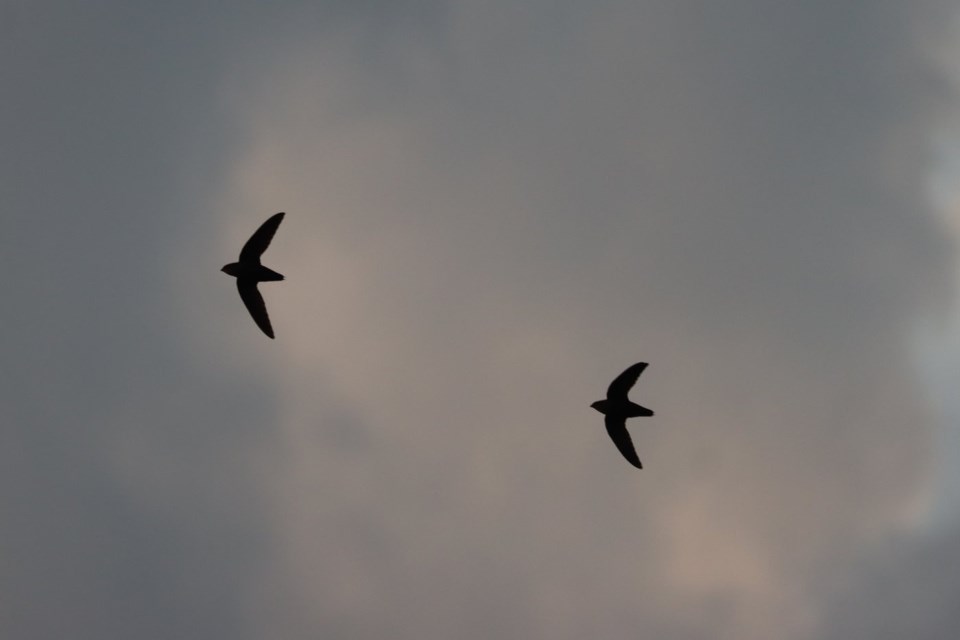FREDERICTON — The spring migratory season got off to an encouraging start for one threatened bird species, a national conservation group says, noting it recently logged thousands of chimney swifts at a single address in Fredricton.
Allison Manthorne, associate director of Atlantic programs with Birds Canada, said chimney swift numbers have dropped by about 90 per cent since the 1970s. So when Birds Canada counted more than 2,400 chimney swifts pouring into a city flue on the evening of May 25, she said the group was pleasantly surprised.
"It's the only large roost that we know of in Fredericton at the moment ... typically, we'll see this kind of pulse in late May of a few hundred birds," she said.
"Sometimes there's a bit of a traffic jam, and maybe it's weather, maybe it's a predator, maybe it's a big storm down south, ... We're not entirely sure what happened to make all of these 2,400 swifts pack into that roost on that particular night."
Manthorne said Birds Canada staff and volunteers participate in a national roost monitoring survey on four set dates across chimney swift nesting sites every year.
Manthorne said the last time Birds Canada counted close to this number of chimney swifts — about 2,700 — was in 2018.
The scimitar-shaped chimney swifts are classified as endangered by the Committee on the Status of Endangered Wildlife in Canada, and are also protected under the Migratory Birds Convention Act.
Environment and Climate Change Canada estimated the chimney swift population stood between 20,000 and 70,000 mature birds as of 2023. It said the long-term goal is to maintain a stable population between 2033 and 2043, while the short-term objective is to halt the drop in numbers within 10 years.
Chimney swifts are long-distance migrants, breeding anywhere between Saskatchewan and Nova Scotia and wintering in South America. They regularly nest in chimneys or other tall stacks on their travels.
Nick Lund, a network manager for U.S. wildlife conservation organization Maine Audubon, called chimney swifts incredible birds.
"They're often called a cigar with wings," he said while describing their short, tubelike bodies flanked by scythe-like appendages.
"They spend their days zooming around over towns and cities, gulping flying insects out of the air. ... They're never seen perched or on the ground, unless you're able to peer into a nest chimney."
Lund said there's a lot to love about chimney swifts, especially for city-dwellers with fewer opportunities to see the natural world in action.
“They're unlike any other bird you'd find in a city — very different from pigeons or starlings — and so they're a great connection to a wilder world for many people."
Scientists say the birds are now threatened due to climate change, habitat loss and pesticide use, which depletes the supply of flying insects they rely on for food.
"It's not just one single threat," Manthorne said. "It's this constellation of threats, and they're doing the best they can to survive."
In 2021, University of Connecticut entomologist David Wagner said climate change, insecticides, herbicides, light pollution, invasive species and changes in agriculture and land use are causing Earth to lose probably one to two per cent of its insects each year.
Insects “are absolutely the fabric by which Mother Nature and the tree of life are built,” Wagner said.
Ripple effects of habitat loss is affecting not just insects, but birds too.
Lund said chimney swifts used to nest in large trees hollowed out by lightning or other forces. But now, he said they nest exclusively in the closest manmade equivalent: chimneys.
Manthorne said the birds have large eyes, short legs and "giant" feet that they use to cling on the inside of hollow trees or chimneys. The birds also have distinctive tails, where each feather has a pointy end that helps the birds climb smokestacks.
"When they're clinging to the inside of a chimney at night, they're using their giant feet with their big claws, and they're using their tails, and they can hang on to the side of a vertical surface all night," she said. "It's really cool."
They often return to past nesting sites, she added, noting that pattern highlights the importance of spots like the roosting site in Fredericton.
Manthorne is troubled by what she says is a common misconception that birds and humans can't comfortably co-exist.
"We always say chimney swifts make really good house guests. They're clean, they're tidy, they're not loud. You probably wouldn't even know that they're there unless somebody told you, 'Hey, I saw a bird flying down your chimney,'" she said.
"If you've got a pair of swifts, it's really special. You're providing a home for this threatened species. And they've chosen your chimney for a reason."
— With files from The Associated Press.
This report by The Canadian Press was first published June 8, 2025.
Hina Alam, The Canadian Press



